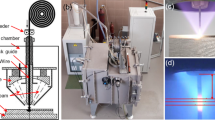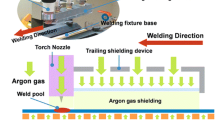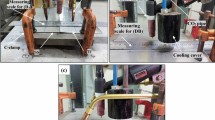Abstract
Wire arc additive manufacturing (WAAM) can be used to repair blades or blisk made of titanium alloy with the advantage of high efficiency and low-cost. In this work, the finite element model of repairing the blade based on the arc heat source was established to investigate it. Results showed that the maximum effect of thermal undercooling appeared when the peak current transformed to the base current (1 Hz or 5 Hz), which will promote the grains refinement with the combination of sufficient constitutional supercooling. Compared to the single-layer deposition, the microstructure in the near-heat affected zone (near-HAZ) of multi-layer deposition changes from the metastable β phases to the extremely fine α phases, which was caused by the repeated thermal cycles.





modified by our previous work [26])

modified by our previous work [26])




modified by our previous work[25], b the microstructure at the near-HAZ, and c the thermal cycle at the near-HAZ
Similar content being viewed by others
References
Srinivasan D (2021) Challenges in qualifying additive manufacturing for turbine components: a review. Trans Indian Inst Met. https://doi.org/10.1007/s12666-021-02199-5
Denkena B, Boess V, Nespor D et al (2015) Engine blade regeneration: a literature review on common technologies in terms of machining. Int J Adv Manuf Technol 81:917–924. https://doi.org/10.1007/s00170-015-7256-2
Zhao H, Zhang G, Yin Z, Wu L (2012) Three-dimensional finite element analysis of thermal stress in single-pass multi-layer weld-based rapid prototyping. J Mater Process Technol 212. https://doi.org/10.1016/j.jmatprotec.2011.09.012
Sun C, Wang Y, McMurtrey MD et al (2021) Additive manufacturing for energy: a review. Appl Energy 282. https://doi.org/10.1016/j.apenergy.2020.116041
Shan JG, Ren JL, Khorunov VF (2002) Repairing of the defects of the engine vanes of an aeroplane by light beam brazing. J Mater Process Technol 121. https://doi.org/10.1016/S0924-0136(01)01187-6
Laux B, Piegert S, Rösler J (2010) Advanced braze alloys for fast epitaxial high-temperature brazing of single-crystalline nickel-base superalloys. J Eng Gas Turbines Power 132. https://doi.org/10.1115/1.3159376
Arhami F, Mirsalehi SE, Sadeghian A, Johar MH (2019) The joint properties of a high-chromium Ni-based superalloy made by diffusion brazing: Microstructural evolution, corrosion resistance and mechanical behavior. J Manuf Process 37. https://doi.org/10.1016/j.jmapro.2018.11.025
Huang X, Miglietti W (2012) Wide gap braze repair of gas turbine blades and vanes-a review. J Eng Gas Turbines Power 134
Ye Y, Zou G, Long W et al (2019) Diffusion brazing repair of IN738 superalloy with crack-like defect: microstructure and tensile properties at high temperatures. Sci Technol Weld Join 24. https://doi.org/10.1080/13621718.2018.1477546
Ma TJ, Li WY, Zhong B et al (2012) Effect of post-weld heat treatment on microstructure and property of linear friction welded Ti17 titanium alloy joint. Sci Technol Weld Join 17. https://doi.org/10.1179/1362171811Y.0000000079
Ma TJ, Chen X, Li WY et al (2016) Microstructure and mechanical property of linear friction welded nickel-based superalloy joint. Mater Des 89. https://doi.org/10.1016/j.matdes.2015.09.143
Parikh VK, Badgujar AD, Ghetiya ND (2019) Joining of metal matrix composites using friction stir welding: a review. Mater Manuf Process 34
Zhang Q, Chen J, Tan H et al (2016) Microstructure evolution and mechanical properties of laser additive manufactured Ti–5Al–2Sn–2Zr–4Mo–4Cr alloy. Trans Nonferrous Met Soc China (English Ed 26). https://doi.org/10.1016/S1003-6326(16)64300-5
He B, Tian XJ, Cheng X et al (2017) Effect of weld repair on microstructure and mechanical properties of laser additive manufactured Ti-55511 alloy. Mater Des 119. https://doi.org/10.1016/j.matdes.2017.01.054
Zhao Z, Chen J, Zhang Q et al (2017) Microstructure and mechanical properties of laser additive repaired Ti17 titanium alloy. Trans Nonferrous Met Soc China (English Ed 27). https://doi.org/10.1016/S1003-6326(17)60289-9
Shen J, Zeng Z, Nematollahi M et al (2021) In-situ synchrotron X-ray diffraction analysis of the elastic behaviour of martensite and H-phase in a NiTiHf high temperature shape memory alloy fabricated by laser powder bed fusion. Addit Manuf Lett 1. https://doi.org/10.1016/j.addlet.2021.100003
Zhang J, Yang Y, Cao S et al (2020) Fine equiaxed β grains and superior tensile property in Ti–6Al–4V alloy deposited by coaxial electron beam wire feeding additive manufacturing. Acta Metall Sin (English Lett 33). https://doi.org/10.1007/s40195-020-01073-5
Wanjara P, Gholipour J, Watanabe E et al (2020) High frequency vibration fatigue behavior of Ti6Al4V fabricated by wire-fed electron beam additive manufacturing technology. Adv Mater Sci Eng. https://doi.org/10.1155/2020/1902567
Wanjara P, Watanabe K, De Formanoir C et al (2019) Titanium alloy repair with wire-feed electron beam additive manufacturing technology. Adv Mater Sci Eng. https://doi.org/10.1155/2019/3979471
Cunningham CR, Flynn JM, Shokrani A et al (2018) Invited review article: strategies and processes for high quality wire arc additive manufacturing. Addit Manuf 22
Xu T, Tang S, Liu C et al (2020) Obtaining large-size pyramidal lattice cell structures by pulse wire arc additive manufacturing. Mater Des 187. https://doi.org/10.1016/j.matdes.2019.108401
Rodrigues TA, Duarte VR, Tomás D et al (2020) In-situ strengthening of a high strength low alloy steel during Wire and Arc Additive Manufacturing (WAAM). Addit Manuf 34. https://doi.org/10.1016/j.addma.2020.101200
Wang J, Lin X, Wang J et al (2018) Grain morphology evolution and texture characterization of wire and arc additive manufactured Ti-6Al-4V. J Alloys Compd 768. https://doi.org/10.1016/j.jallcom.2018.07.235
Aschenbruck J, Adamczuk R, Seume JR (2014) Recent progress in turbine blade and compressor blisk regeneration. Procedia CIRP. https://doi.org/10.1016/j.procir.2014.07.016
Zhuo Y, Yang C, Fan C et al (2020) Microstructure and mechanical properties of wire arc additive repairing Ti–6.5Al–2Sn–2Zr–4Mo–4Cr titanium alloy. Mater Sci Technol (United Kingdom) 36. https://doi.org/10.1080/02670836.2020.1822061
Zhuo Y, Yang C, Fan C et al (2021) Grain refinement of wire arc additive manufactured titanium alloy by the combined method of boron addition and low frequency pulse arc. Mater Sci Eng A 805. https://doi.org/10.1016/j.msea.2020.140557
Shan XY, Tan MJ, O’Dowd NP (2007) Developing a realistic FE analysis method for the welding of a NET single-bead-on-plate test specimen. J Mater Process Technol 192–193. https://doi.org/10.1016/j.jmatprotec.2007.04.080
Goldak J, Chakravarti A, Bibby M (1984) A new finite element model for welding heat sources. Metall Trans B 15. https://doi.org/10.1007/BF02667333
Ding J, Colegrove P, Mehnen J et al (2011) Thermo-mechanical analysis of wire and arc additive layer manufacturing process on large multi-layer parts. Comput Mater Sci 50. https://doi.org/10.1016/j.commatsci.2011.06.023
Galarraga H, Lados DA, Dehoff RR et al (2016) Effects of the microstructure and porosity on properties of Ti-6Al-4V ELI alloy fabricated by electron beam melting (EBM). Addit Manuf 10. https://doi.org/10.1016/j.addma.2016.02.003
Bambach M, Sizova I, Sydow B et al (2020) Hybrid manufacturing of components from Ti-6Al-4V by metal forming and wire-arc additive manufacturing. J Mater Process Technol 282. https://doi.org/10.1016/j.jmatprotec.2020.116689
Zhou Y, Qin G, Li L et al (2020) Formability, microstructure and mechanical properties of Ti-6Al-4V deposited by wire and arc additive manufacturing with different deposition paths. Mater Sci Eng A 772. https://doi.org/10.1016/j.msea.2019.138654
Liu Q, Wang Y, Zheng H et al (2016) TC17 titanium alloy laser melting deposition repair process and properties. Opt Laser Technol 82. https://doi.org/10.1016/j.optlastec.2016.02.013
Funding
This work was supported by the National Science and Technology Major Project of China (Grant 2019-VII-0004-0144).
Author information
Authors and Affiliations
Contributions
Yimin Zhuo: experiment, methodology, writing — original draft preparation. Chunli Yang: supervision, validation. Chenglei Fan: writing — reviewing, investigation, data curation. Sanbao Lin: writing — reviewing, validation.
Corresponding author
Ethics declarations
Ethical approval
Not applicable.
Consent to participate
Not applicable.
Consent for publication
Not applicable.
Competing interests
The authors declare no competing interests.
Additional information
Publisher's note
Springer Nature remains neutral with regard to jurisdictional claims in published maps and institutional affiliations.
Rights and permissions
About this article
Cite this article
Zhuo, Y., Yang, C., Fan, C. et al. Effects of thermal undercooling and thermal cycles on the grain and microstructure evolution of TC17 titanium alloy repaired by wire arc additive manufacturing. Int J Adv Manuf Technol 124, 3161–3169 (2023). https://doi.org/10.1007/s00170-021-08445-w
Received:
Accepted:
Published:
Issue Date:
DOI: https://doi.org/10.1007/s00170-021-08445-w




